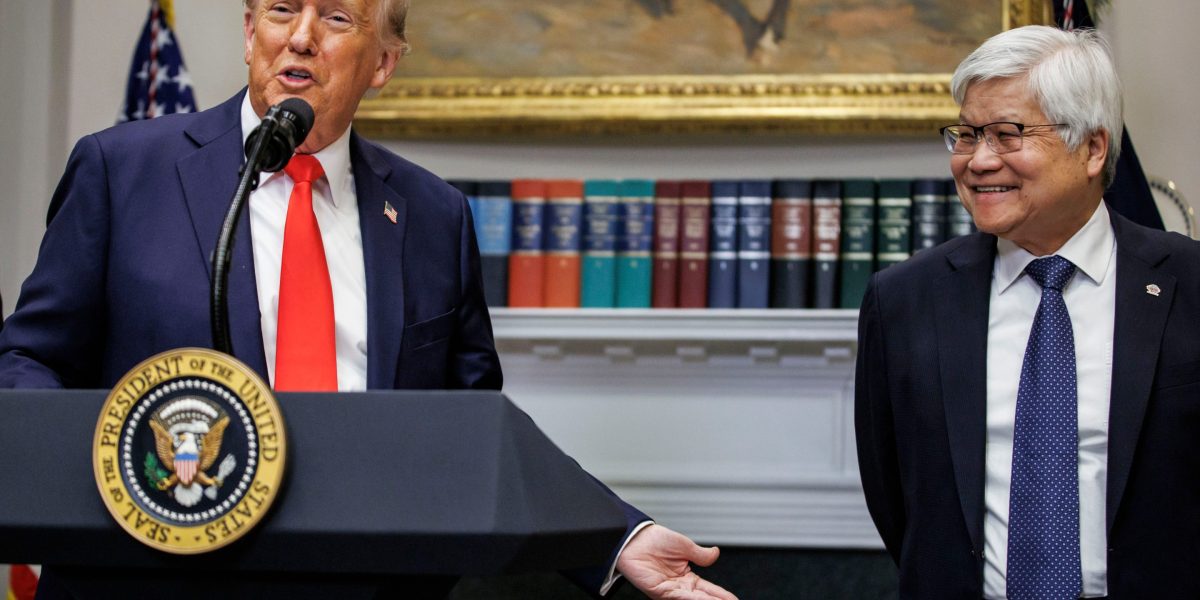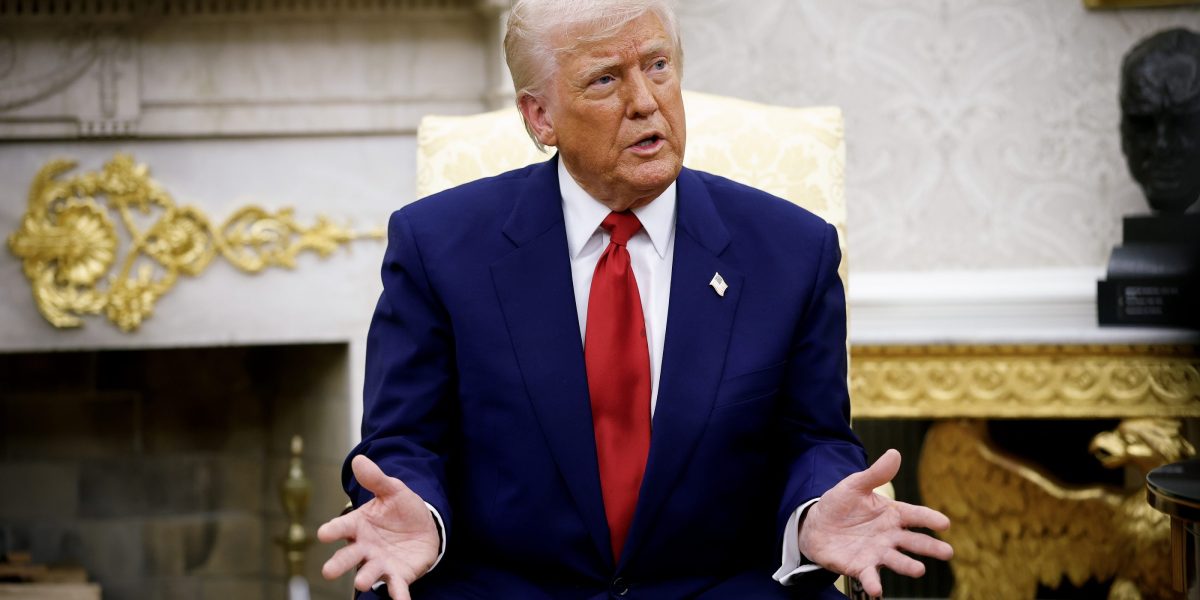- EXPLAINER: President Trump has revealed one of the most aggressive tariff agendas in recent history following the announcement of significant hikes on the likes of China, India and the EU, as well as a 10% blanket raise on all other nations. While President Trump’s bruising foreign agenda may have shaken markets, his approach isn’t anything new.
President Donald Trump says he wants to level the playing field with the tariff agenda he announced this week. While the economic sanctions may go some way to achieving his aims, experts fear the aggressive foreign policy might also isolate the largest economy on the planet.
This week the White House ripped up decades-long playbooks with some of its closest trading partners. The EU, for example, will be subject to 20% tariffs while China is facing a cumulative hike of 54%.
And when President Trump said “all countries” would be subject to Liberation Day, he meant it. The nations which weren’t given a specified tariff are facing an immediate, blanket duty of 10%.
In the hours following the Rose Garden address foreign leaders began formulating their responses. Some, like Britain’s Prime Minister Sir Keir Starmer, said they would keep a “cool head” as negotiations continue, while President of the European Commission Ursula Von Der Leyen promised swift and ongoing retaliation if agreements can’t be made.
The ultimate question remains: Will President Trump’s protectionist agenda pay off? Will he be able to Make America Wealthy Again at the cost of burned bridges?
Or, will he fall foul of pitfalls discovered by his predecessors?
What’s Trump’s aim?
Treasury Secretary Scott Bessent laid out in his confirmation hearings the aims of President Trump’s tariff plan.
Some related directly to the America’s people and businesses—for example, creating and protecting U.S. jobs, increasing industrial capacity by making domestic products more competitive, and raising revenues to fund investments for families and businesses.
Other targets related to advancing America’s position on the global stage—for example, reducing dependence on rival countries—particularly when it comes to national security needs—as well as leveraging economic sanctions to advance the security interests of the U.S.
Of course, the first raft of tariffs President Trump announced addressed none of these things: The tools were used as negotiating tools in a debate over immigration and fentanyl supply into the U.S.
Columbia professor Brett House argues there’s another motive to Trump’s action, exemplified by the fact that the White House has implemented both individual and blanket tariffs. He told Fortune: “The president loves creating a situation where other countries or individuals have to come and bargain with him. By setting out different tariff rates on a country-by-country basis, it creates a situation where every country then has to supplicate and beg and negotiate with the White House on an individual basis.
“This is the essence of the kind of power that a bully and an autocrat tries to create by dividing people and ensuring that it is very difficult for them to unite and negotiate with a single voice.”
Cracking the tariff code
Other economists take a different view, prompted in part by the White House sharing its methodology for how it formulated the tariff rates: Essentially, taking the goods trade deficit between the U.S. and a given country, dividing that by the total goods imported from that nation, and divide it by two.
“[The tariffs] are primarily about eliminating dependency on the rest of the world—or what is perceived as [America’s] excessive dependency on the rest of the world and other countries,” explained Joao Gomes, senior vice dean of research at the University of Pennsylvania’s Wharton Business School.
“Eliminating the trade deficit is the most important thing when you look at the numbers and you understand how they’re competed, it’s just obvious they want to literally eliminate trade balances. They view that as an unacceptable vulnerability… It’s not about just politics, it’s not selling nationalism.
“This is truly about fundamental economic principles and I may not agree with them, but at least now I understand better what they want to accomplish and I think that helps with predictability.”
Has anything like this been done before?
For economists to draw comparisons on remotely similar policy out of the White House they’d have to dust off the history books—and turn back the pages by a century.
In 1930, as the world sunk into the Great Depression, President Hoover signed the Smoot-Hawley Tariff Act into law in a bid to protect American businesses and farmers from being undercut by cheaper agriculture products imported from abroad.
Prior to Smoot-Hawley the average import tariff sat at approximately 35.7%, according to calculations by Douglas Irwin, a professor of economics at Dartmouth University, and rose to an average of 41.1% following the bill. Likewise the Fordney McCumber Tariff Act brought into effect in 1922 hiked tariffs from 21% to 38.8%.
By comparison the 10% Trump has placed on the United Kingdom, for example, or the 20% placed on the EU seems relatively more restrained.
Yet the economy has moved on in the 100 years since the last major tariff changes—globalization has continued to ramp up since then, and the U.S. economy is more closely intwined with the health of its partners.
As Dartmouth’s Irwin points out, in 1930 and 1922 imports as a percentage of GDP represented just 1.4% and 1.3% respectively. By 2025, even the tariffs announced prior to April 2 (those on Canada, Mexico, and the initial 20% on China) were on imports worth a little under 5% of America’s GDP.
As such, lower tariffs on a much higher proportion of goods—and potential reciprocal tariffs from rival nations—may prove to be a more painful pill to swallow than the fewer goods at a higher tariff rate experienced in the past.
While President Trump himself has used Smoot-Hawley as a justification for his tariff action, Wharton’s Gomes told Fortune the two instances are so far removed that it’s a “ridiculous comparison.”
On the simplest level, he explained: “I would say A) [The 1930s] was a recession to begin with, B) We had the gold standard and the monetary policy was all about protecting the gold standard, which led to enormous deflation.”
Transatlantic examples
Tariffs can be useful bargaining chips in a negotiation sense and—depending on who you ask—can produce some economic benefits.
The University of Cambridge professor of macroeconomics Michael Kitson admits he is in the minority of his peers when he highlights the general tariff imposed by the U.K. in 1932 may have yielded some boons to the economy—he points to a surge in manufacturing between 1932 and 1937, for example.
However, the 10% duty the U.K. imposed was a far cry from the sweeping changes made by President Trump, and Kitson highlights the conditions which allowed for any benefit to the U.K. economy are not present in 2025 America.
These “peculiar condition” included high unemployment rates (the U.S. unemployment rate is currently a steady 4.1%), tariffs were imposes on competitive imports not complimentary imports like raw materials and food (President Trump has already announced a 25% hike on aluminum and steel) and the exchange rate wasn’t allowed to appreciate to a level where it could wipe out the gains made by tariffs.
And, most notably, there wasn’t a lot of potential for other countries to retaliate (the EU, for example, could now add a levy to American service exports which it was unable to do previously).
“Most of those conditions don’t apply to the U.S. now,” Kitson told Fortune, saying that not only are these conditions not met, there are compounding factors pushing the U.S. economy even further away from tariff success.
“What we have now is much more complex supply chains than we had in the 1930s that makes the likely impact of tariffs more complicated and more likely to be negative,” he added.
Is there any merit in the hard reset theory?
The S&P 500 tanking 5% courtesy of Trump’s tariff announcement is precisely the opposite of what many analysts expected when he first won the Oval Office.
It has led some to speculate whether President Trump’s intention is to engineer a “hard reset” with the economy slowed in order to curb inflation, lower interest rates, and weaken the dollar—all creating a more stable economic landscape for the Republicans to govern over.
Initially many analysts dismissed the theory as conspiracy. Yet Kevin Ford, FX and macro strategist at Convera, is coming around to the notion: “I’m starting to see the reasoning, at least partially, especially when I see Trump and his cabinet shifting their focus to the debt market.
“In three of the last four State of the Union addresses, Trump spotlighted the stock market, often touting its strong performance. But recently, both he and his team have gone quiet on that front, instead turning their attention to the 10-year yield. Many had anticipated the so-called ‘Trump put’ to step in and stabilize the recent market declines, which hasn’t showed up.”
Ford added that the acceptance of “disruption” compared to promises of a Golden Era under Trump are further indicators, saying: “I don’t think the administration is aiming for a bear market or a sharp economic recession. But if deflating financial asset bubbles is the price to pay, it seems like they’re willing to take the heat. Their rhetoric feels unified—Trump, Lutnick, Bessent—they’re all aligned on the message of short-term pain.”
Of course a J-curve economic trajectory (a short dip before a dramatic gain) would serve to cool down activity without sparking a recession, but Ford added: “Their policy balancing act is tricky—some might even call it a gamble—especially when you factor in immigration, DOGE, and retaliatory measures from other countries.
“It’s a big question mark, but as time goes on, the idea of engineering a J-curve economic reshuffling doesn’t seem so far-fetched anymore.”
Forgotten service sector
In much of the back-and-forth over tariffs there’s a glaring omission: The motivation for this action is based on goods deficits, ignoring America’s huge service sector which accounts for two-thirds of the nation’s economic activity.
In fact, the White House’s fact sheet confirming the tariffs doesn’t mention the service sector once—despite the fact it is the largest services exporter in the world.
The impact these tariffs will have on the sector cannot be ignored, said Ebehi Iyoha, a professor of business administration at Harvard Business School.
Iyoha is due to release a working paper on the impact of tariffs on SMEs in partnership with business network Alignable, carried out prior to April 2. Respondents were not aware of the tariffs already placed on the likes of China, Canada and Mexico, Iyoha added, perhaps understandable for founders and entrepreneurs without a large team behind them.
However Iyoha said that the impact of foreign policy on service-sector businesses cannot be overlooked, telling Fortune: “Some of the the firms in our sample are firms who are in the tourism sector. If we think about the downstream effects of these tariffs on people’s willingness, for example, to visit the United States, to spend on these service sectors that these small businesses operate in, then how do we balance that out?
“There’s been a lot of focus [in] the trade policy rhetoric on goods, but they’re not really thinking: ‘How has the U.S. benefited in global traded services, and how have [small businesses] benefited from this global trade integration. It’s something that I think is constantly missing in the conversation.”
This story was originally featured on Fortune.com
Source link


 Entertainment8 years ago
Entertainment8 years ago
 Politics8 years ago
Politics8 years ago
 Entertainment8 years ago
Entertainment8 years ago
 Entertainment8 years ago
Entertainment8 years ago
 Tech8 years ago
Tech8 years ago
 Tech8 years ago
Tech8 years ago
 Tech8 years ago
Tech8 years ago
 Politics8 years ago
Politics8 years ago






